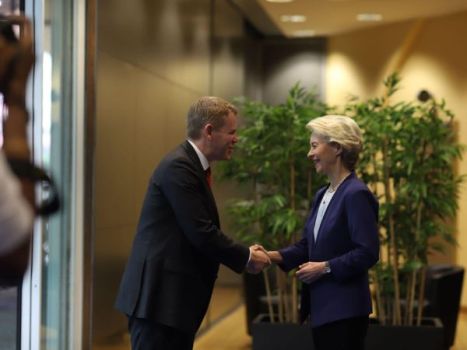New Zealand and the European Union have overnight signed a ground-breaking Free Trade Agreement that will provide significant new trade access to our fourth-largest trading partner.
“The EU FTA will increase our exports to the EU by up to $1.8 billion per year by 2035,” Chris Hipkins said.
“Tariff savings on New Zealand exports are $100 million from day one of the agreement entering into force, the highest immediate tariff saving delivered by any New Zealand FTA. That’s around three times the immediate savings from the UK FTA.

“When I became Prime Minister I said securing trade deals for our exporters would be a top priority. Between this and the UK FTA we will save around $150 million annually in tariffs on our exports as well as adding billions every year to New Zealand’s GDP,” Chris Hipkins said.
Minister for Trade and Export Growth Damien O’Connor said the NZ-EU FTA will cut costs and support exporters to grow and diversify their trade.
“It will provide significant new opportunities for our world-leading exporters of products such as kiwifruit, seafood, onions, honey, wine, butter, cheese, beef and sheep meat. This new access will help to accelerate our post-Covid recovery, while providing a boost to our regions as they grapple with the longer-term effects of Cyclone Gabrielle,” Damien O’Connor said.
“Based on current trade figures New Zealand will have the opportunity through combined FTA and WTO quotas to provide up to 60 percent of the EU’s butter imports – up from 14 percent today. New Zealand cheeses could also make up 15 per cent of the EU’s imported cheeses, up from 0.5 percent today, which is no mean feat for a small nation like ours.
“The FTA also builds on our already sizeable WTO quota for sheep meat, meaning that if farmers use this new access, we could account for up to 96 percent of EU imports. This provides further trade resilience for our exporters, while expanding by eight-fold our access for beef.
“New Zealand producers are some of the most sustainable in the world and these credentials resonate well with EU consumers. New Zealand and the EU share similar values and a commitment to high labour, environment and animal welfare standards.
“The NZ-EU FTA includes ambitious sustainable trade outcomes in a range of areas, including climate change, labour rights, women’s economic empowerment, environmentally harmful fisheries and fossil fuel subsidies.
“We’ve got to keep on our path to lower emissions if we want high quality trade deals that benefit our economy,” Damien O’Connor said.
The FTA contains another important ‘EU first’ that New Zealand worked hard to secure – a Māori Trade and Economic Cooperation chapter that will create a platform for greater engagement with the EU on Māori economic and trade interests.
The agreement was signed in Brussels by Minister for Trade and Export Growth, Damien O’Connor and the EU Executive Vice President and Trade Commissioner Valdis Dombrovskis, witnessed by Prime Minister Chris Hipkins and EU President Ursula von der Leyen.
It is anticipated that the NZ-EU FTA will enter into force in the first half of 2024, once both parties complete the final required legal steps.
For more information on the NZ-EU FTA go to www.mfat.govt.nz/eufta
Did you know?
- · New Zealand’s horticultural sector, one of the biggest exporters to the EU and worth $714 million per year, will see $46 million in tariffs slashed from day one.
- · Our fish and seafood producers will see immediate removal of $20 million in tariffs of between 7-25 percent on exports worth $241 million.
- · Major honey exporting regions like Northland, Hawke’s Bay, and the Coromandel will benefit from the phased removal of the 17 percent tariff on honey over three years, and for Mānuka honey right from day one.
- · New Zealand’s dairy and red meat sectors will gain sizable new opportunities to the value of $600 million which, if filled, for products such as butter and cheese, will see trade able to flow more freely for the first time in many years.
- · Access for beef increases eight-fold, while for sheep meat we could account for up to 96 percent of EU imports. This is under New Zealand’s new FTA quota access combined with existing WTO quota, which means additional trade resilience.
- · New Zealand consumers and businesses will also benefit from access to cheaper products imported from the EU as tariffs are eliminated on a range of goods, including footwear, apparel, cosmetics, furniture, chocolate, kitchen appliances, machinery, motor homes, forklifts and some agricultural goods. This should make a difference to the cost of living, and provide greater supply-chain flexibility and resilience for Kiwi businesses.
- · New Zealand service providers, including independent professionals, will benefit from the FTA’s commitments to facilitate the entry and temporary stay of business people. These commitments include streamlined and transparent visa application processes, the setting of reasonable fees for visas, as well as locking in place minimum visa commitments for New Zealand service suppliers. These commitments will also benefit New Zealand companies looking for overseas expertise and experience to further develop and enhance their competitiveness, giving them easier access to specialists from the EU, who can help build their business.



